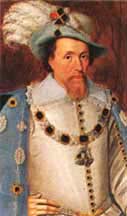 James I
James IHouse of Stuart -- Reigned: 1603-1625 1566-1625
James ascended the Scottish throne upon the abdication of his mother in 1567, but Scotland was ruled by regent until James reached his majority. He married Anne of Denmark in 1589, who bore him three sons and four daughters: Henry, Elizabeth, Margaret, Charles, Robert, Mary and Sophia. He was named successor to the English throne by his cousin, Elizabeth I and ascended that throne in 1603. James died of a stroke in 1625 after ruling Scotland for 58 years and England for 22 years. James was profoundly affected by his years as a boy in Scottish court. Murder and intrigue had plagued the Scottish throne throughout the reigns of his mother and grandfather (James V) and had no less bearing during James's rule. His father had been butchered mere months after James' birth by enemies of Mary, and Mary, because of her indiscretions and Catholic faith, was forced to abdicate the throne. Thus, James developed a guarded manner. He was thrilled to take the English crown and leave the strictures and poverty of the Scottish court. James' twenty-nine years of Scottish kingship did little to prepare him for the English monarchy: England and Scotland, rivals for superiority on the island since the first emigration of the Anglo-Saxon races, virtually hated each other. This inherent mistrust, combined with Catholic-Protestant and Episcopal-Puritan tensions, severely limited James' prospects of a truly successful reign. His personality also caused problems: he was witty and well-read, fiercely believed in the divine right of kingship and his own importance, but found great difficulty in gaining acceptance from an English society that found his rough-hewn manners and natural paranoia quite unbecoming. James saw little use for Parliament. His extravagant spending habits and nonchalant ignoring of the nobility's grievances kept king and Parliament constantly at odds. He came to the thrown at the zenith of monarchical power, but never truly grasped the depth and scope of that power. Religious dissension was the basis of an event that confirmed and fueled James' paranoia: the Gunpowder Plot of November 5, 1605. Guy Fawkes and four other Catholic dissenters were caught attempting to blow up the House of Lords on a day in which the king was to open the session. The conspirators were executed, but a fresh wave of anti-Catholic sentiments washed across England. James also disliked the Puritans who became excessive in their demands on the king, resulting in the first wave of English immigrants to North America. James, however, did manage to commission an Authorized Version of the Bible, printed in English in 1611. The relationship between king and Parliament steadily eroded. Extravagant spending (particularly on James' favorites), inflation and bungled foreign policies discredited James in the eyes of Parliament. Parliament flatly refused to disburse funds to a king who ignored their concerns and were annoyed by rewards lavished on favorites and great amounts spent on decoration. James awarded over 200 peerages (landed titles) as, essentially, bribes designed to win loyalty, the most controversial of which was his creation of George Villiers (his closest advisor and homosexual partner) as Duke of Buckingham. Buckingham was highly influential in foreign policy, which failed miserably. James tried to kindle Spanish relations by seeking a marriage between his son Charles and the Spanish Infanta (who was less than receptive to the clumsy overtures of Charles and Buckingham), and by executing Sir Walter Raleigh at the behest of Spain. James was not wholly unsuccessful as king, but his Scottish background failed to translate well into a changing English society. He is described, albeit humorously, 1066 and All That (a British satire), as such:
|
All rights reserved. For details and contact information: See License Agreement, Copyright Notice. |
 James I was born in 1566 to Mary Queen of Scots and her second husband, Henry Stewart, Lord Darnley. He descended from the Tudors through Margaret, daughter of
James I was born in 1566 to Mary Queen of Scots and her second husband, Henry Stewart, Lord Darnley. He descended from the Tudors through Margaret, daughter of